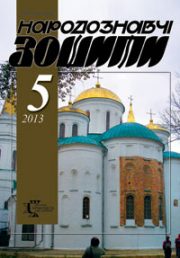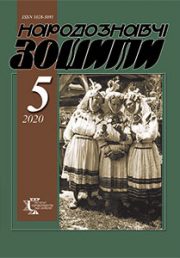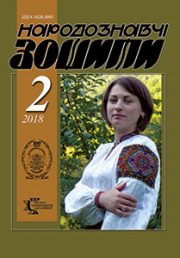The Ethnology notebooks, 2017, 1, 82–84
UDK 39(477.86):930
DOI https://doi.org/10.15407/nz2017.01.082
Received 1.02.2017
TO THE POKUTTIAS ETHNOGRAPHY SCOURCES (the third quarter of the nineteenth century)
Bilous Vira, PhD in History, Senior Researcher of the Institute of Ethnology of the National Academy of Sciences of Ukraine
Svobody Avenue 15, Lviv, Ukraine.
Contact: tel: 097-47-22-872; e-mail: bilka3@gmail.com
Abstract. There has been determined the informational value of V. Zalozetsky’s work and V. Ploschansky’s materials in order to traditional culture studies and way of life of residents of Pokuttia.
Keywords: Pokuttia, local history essays, factual material, Galician Periodicals.
REFERENCES
Dopis iz L’vova (Rasporjazhen’e duhovnoj vlasti). (1864). Slovo, 61 [in Russian].
Opisanie gde-jakih sel znahodjashhihsja v Galichine. (1868). In Pokutjanin. Mysjaceslov kolomyjskij na god 1869. (p.p. 28—29, 32). Kolomyya [in Russian].
Ploshhanskij, V. (1864). V spravi opisanija Galickoj Rusi v otnoshenijah: topografichnom, istoricheskom i statistichnom. Slovo, 69, 70, 74 [in Russian].
Ploshhanskij, V. (1875). Dlja monografij mestnostej v Galicii. Slovo, 26, 32, 36, 41, 55 [in Russian].
Ploshhanskij, V. (1871). Zaval’e, selo Galickoj Rusi. In Literaturnyj sbornik izdavaemyj Galicko-russkoju Maticeju (p.p. 65—66). L’viv [in Russian].
Ploshhanskij, V. (1871). Nekotorye sela Galickoj Rusi. In Literaturnyj sbornik izdavaemyj Galicko-russkoju Maticeju (p.p. 50—57). L’viv [in Russian].
Załoziecki, W. (1854). Obrazki z cyrkyłu Kołomyjśkiego. Dodatek tygodniowy przy Gazecie Lwowskiej, 1, 2, 6, 7, 9, 10, 21—26, 38, 39 [in Polish].
Opisanie gde-jakih sel znahodjashhihsja v Galichine. (1868). In Pokutjanin. Mysjaceslov kolomyjskij na god 1869. (p.p. 28—29, 32). Kolomyya [in Russian].
Ploshhanskij, V. (1864). V spravi opisanija Galickoj Rusi v otnoshenijah: topografichnom, istoricheskom i statistichnom. Slovo, 69, 70, 74 [in Russian].
Ploshhanskij, V. (1875). Dlja monografij mestnostej v Galicii. Slovo, 26, 32, 36, 41, 55 [in Russian].
Ploshhanskij, V. (1871). Zaval’e, selo Galickoj Rusi. In Literaturnyj sbornik izdavaemyj Galicko-russkoju Maticeju (p.p. 65—66). L’viv [in Russian].
Ploshhanskij, V. (1871). Nekotorye sela Galickoj Rusi. In Literaturnyj sbornik izdavaemyj Galicko-russkoju Maticeju (p.p. 50—57). L’viv [in Russian].
Załoziecki, W. (1854). Obrazki z cyrkyłu Kołomyjśkiego. Dodatek tygodniowy przy Gazecie Lwowskiej, 1, 2, 6, 7, 9, 10, 21—26, 38, 39 [in Polish].







